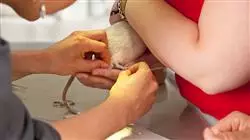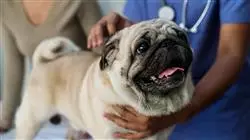University certificate
The world's largest faculty of veterinary medicine”
Introduction to the Program
We offer you the most comprehensive training on the market to bring the business management side of your veterinary center to the same level as the clinical and sanitary practice, offering your clients the highest quality in both services"

Human Resources Management in Veterinary Centers is a task of utmost importance, because the staff in this type of facilities is the most valuable asset of the company, since, being service providers, they are people who offer solutions to the problems of the clients.
The selection, integration, motivation and development of people who make up the working teams are vital for the success of the business. Thus, if it is not done properly, the processes carried out in the center will surely fail and it will seriously affect the quality of services provided and, therefore, the satisfaction of the users.
Therefore, it is necessary for the manager to know the characteristics and qualities of each employee in depth, with the aim of placing them in the most appropriate position according to their skills, where they will be able to achieve the best performance, offering a better service and achieving customer loyalty.
It should be taken into account that the lack of university training on business management in the veterinary degree has a great influence on the lack of awareness of the future entrepreneur when it comes to professionally managing their veterinary center, prioritizing, in reality, the medical and surgical practice aspects instead.
At present, one of the main problems affecting continuing postgraduate specialization is its compatibility with work and personal life. Current professional demands make it difficult to achieve quality, specialized training in person, so the online format will allow students to combine this specialized training with their daily professional practice, without losing their connection to training and specialization.
Immerse yourself in this high quality educational training, which will enable you to face the future challenges within Human Resources Human Resources Management in Veterinary Centers”
This Postgraduate diploma in Human Resources Management in Veterinary Centers contains the most complete and up-to-date educational program on the market. The most important features include:
- The development of case studies presented by experts in the Human Resources Management in Veterinary Centers
- The graphic, schematic, and practical contents with which they are created, provide scientific and practical information on the disciplines that are essential for professional development
- Latest innovations in Human Resources Management in Veterinary Centers
- Practical exercises where the self-assessment process can be carried out to improve learning
- Special emphasis on innovative methodologies for Human Resources Management in Veterinary Centers
- Theoretical lessons, questions to the expert, debate forums on controversial topics, and individual reflection work
- Content that is accessible from any fixed or portable device with an Internet connection
This Postgraduate diploma is the best investment you can make when choosing a refresher program to update your knowledge in Human Resources Management in Veterinary Centers"
Its teaching staff includes professionals belonging to the field of Business Strategies in Veterinary Centers, who bring to this training the experience of their work, as well as renowned specialists from reference societies and prestigious universities.
The multimedia content, developed with the latest educational technology, will provide the professional with situated and contextual learning, i.e., a simulated environment that will provide immersive training programmed to train in real situations.
This program is designed around Problem-Based Learning, whereby the specialist must try to solve the different professional practice situations that arise throughout the program. For this purpose, the professional will be assisted by an innovative system of interactive videos made by renowned and experienced experts in Human Resources Management in Veterinary Centers.
This training comes with the best didactic material, providing you with a contextual approach that will facilitate your learning"

This 100% online Postgraduate diploma will allow you to combine your studies with your professional work while expanding your knowledge in this field"
Why study at TECH?
TECH is the world’s largest online university. With an impressive catalog of more than 14,000 university programs available in 11 languages, it is positioned as a leader in employability, with a 99% job placement rate. In addition, it relies on an enormous faculty of more than 6,000 professors of the highest international renown.

Study at the world's largest online university and guarantee your professional success. The future starts at TECH”
The world’s best online university according to FORBES
The prestigious Forbes magazine, specialized in business and finance, has highlighted TECH as “the world's best online university” This is what they have recently stated in an article in their digital edition in which they echo the success story of this institution, “thanks to the academic offer it provides, the selection of its teaching staff, and an innovative learning method aimed at educating the professionals of the future”
A revolutionary study method, a cutting-edge faculty and a practical focus: the key to TECH's success.
The most complete study plans on the university scene
TECH offers the most complete study plans on the university scene, with syllabuses that cover fundamental concepts and, at the same time, the main scientific advances in their specific scientific areas. In addition, these programs are continuously being updated to guarantee students the academic vanguard and the most in-demand professional skills. In this way, the university's qualifications provide its graduates with a significant advantage to propel their careers to success.
TECH offers the most comprehensive and intensive study plans on the current university scene.
A world-class teaching staff
TECH's teaching staff is made up of more than 6,000 professors with the highest international recognition. Professors, researchers and top executives of multinational companies, including Isaiah Covington, performance coach of the Boston Celtics; Magda Romanska, principal investigator at Harvard MetaLAB; Ignacio Wistumba, chairman of the department of translational molecular pathology at MD Anderson Cancer Center; and D.W. Pine, creative director of TIME magazine, among others.
Internationally renowned experts, specialized in different branches of Health, Technology, Communication and Business, form part of the TECH faculty.
A unique learning method
TECH is the first university to use Relearning in all its programs. It is the best online learning methodology, accredited with international teaching quality certifications, provided by prestigious educational agencies. In addition, this disruptive educational model is complemented with the “Case Method”, thereby setting up a unique online teaching strategy. Innovative teaching resources are also implemented, including detailed videos, infographics and interactive summaries.
TECH combines Relearning and the Case Method in all its university programs to guarantee excellent theoretical and practical learning, studying whenever and wherever you want.
The world's largest online university
TECH is the world’s largest online university. We are the largest educational institution, with the best and widest online educational catalog, one hundred percent online and covering the vast majority of areas of knowledge. We offer a large selection of our own degrees and accredited online undergraduate and postgraduate degrees. In total, more than 14,000 university degrees, in eleven different languages, make us the largest educational largest in the world.
TECH has the world's most extensive catalog of academic and official programs, available in more than 11 languages.
Google Premier Partner
The American technology giant has awarded TECH the Google Google Premier Partner badge. This award, which is only available to 3% of the world's companies, highlights the efficient, flexible and tailored experience that this university provides to students. The recognition as a Google Premier Partner not only accredits the maximum rigor, performance and investment in TECH's digital infrastructures, but also places this university as one of the world's leading technology companies.
Google has positioned TECH in the top 3% of the world's most important technology companies by awarding it its Google Premier Partner badge.
The official online university of the NBA
TECH is the official online university of the NBA. Thanks to our agreement with the biggest league in basketball, we offer our students exclusive university programs, as well as a wide variety of educational resources focused on the business of the league and other areas of the sports industry. Each program is made up of a uniquely designed syllabus and features exceptional guest hosts: professionals with a distinguished sports background who will offer their expertise on the most relevant topics.
TECH has been selected by the NBA, the world's top basketball league, as its official online university.
The top-rated university by its students
Students have positioned TECH as the world's top-rated university on the main review websites, with a highest rating of 4.9 out of 5, obtained from more than 1,000 reviews. These results consolidate TECH as the benchmark university institution at an international level, reflecting the excellence and positive impact of its educational model.” reflecting the excellence and positive impact of its educational model.”
TECH is the world’s top-rated university by its students.
Leaders in employability
TECH has managed to become the leading university in employability. 99% of its students obtain jobs in the academic field they have studied, within one year of completing any of the university's programs. A similar number achieve immediate career enhancement. All this thanks to a study methodology that bases its effectiveness on the acquisition of practical skills, which are absolutely necessary for professional development.
99% of TECH graduates find a job within a year of completing their studies.
Postgraduate Diploma in Human Resources Management in Veterinary Centers
The area of human capital is a fundamental pillar for the proper functioning of any organization. This is why professionals focused on this sector seek constant updating of knowledge to contribute their best techniques and skills to the improvement of the company's processes. For this reason, at TECH we have designed a Postgraduate Diploma in Human Resources Management in Veterinary Centers; a high-level academic program focused on providing the necessary foundations to manage this sector. With this course you will be able to acquire management skills and become an expert in leadership, production processes and strategic planning of the staff in a veterinary care space. Take this course and get certified in the largest digital university in the world, you can maximize your capabilities to achieve professional success.
Perform a Postgraduate Diploma online
At TECH Global University we have the largest Faculty of Veterinary, we provide the most comprehensive online training market to achieve proper business management focused on the area of human capital. Throughout 450 hours you will be able to update your knowledge and acquire new skills to improve the performance of your work in this area. You will cover topics such as the formation of a veterinary center team, internal communication, recruitment of future collaborators and the incorporation of new talent to strengthen the sector. This will enable you to provide the best possible care to all clients by generating complete satisfaction in the delivery of these services.
Specialize in the management of human talent in veterinary care
Highlight your career and acquire the necessary skills to boost the growth of your professional life. In TECH you will find the latest educational technology, you will have at your fingertips the most complete curriculum by learning about managerial responsibilities, the characteristics for personnel management, time management of a veterinary care center and the identification and resolution of internal conflicts in these spaces. As a result, you will be able to provide unique experiences for clients and improve loyalty in your workspace, without neglecting the correct medical practice and the necessary clinical care. Likewise, you will be able to complement your curriculum with graphic content, theoretical lessons and high-level practical exercises.







